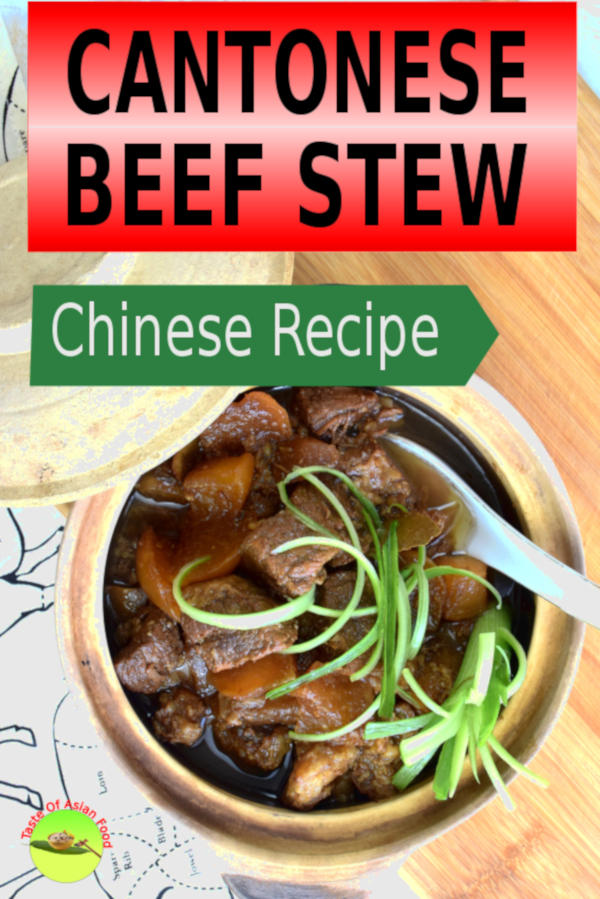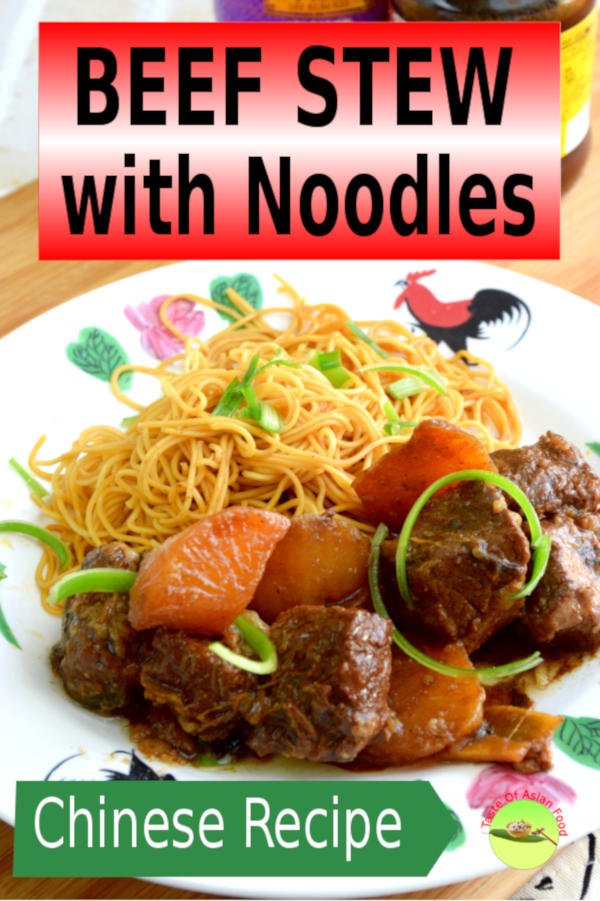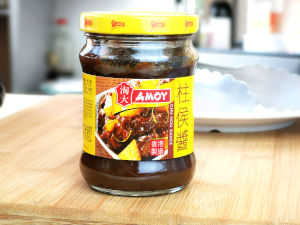How to Make Chinese Beef Stew
The best Chinese beef stew (柱侯蘿蔔炆牛腩) I accept e'er tasted was at an old school java shop in Aberdeen, Hong Kong.
They cooked by the traditional way, zero fancy, but did it exceptionally well. Serve with a basin of noodles on the side, and it is heavenly.
Afterward a few months of not enjoying the beef stew, I am tempting to develop my version since I practice not visit Hong Kong very frequently.
I grew up eating Cantonese food and still prefer Cantonese food equally my staple over other forms of cooking. Therefore, I am keeping this Chinese beefiness brisket recipe equally close to the traditional Cantonese style.
It is a relatively easy Chinese beefiness brisket recipe. The nearly critical 'technique' is to be patient- let information technology stew at barely boil temperature for over two hours. Other than that, there are a few tricks that I volition highlight in the following sections.

Note: This mail service may incorporate affiliate links. Please read my privacy policy for more info. I may receive commissions for purchases made through links in this post.
How to brand Chinese beef stew (Cantonese style)
1. Blanch the beefiness brisket
The almost suitable cuts for this Chinese beef stew is the beef brisket and tendon. Both are tough but very flavorful, which is platonic for stewing. Other cuts like chuck and rump tin can be used, only brisket has layers of fats in between the lean meat which works best for tiresome cooking.
Hither are the steps:
- Put the beef in a stock pot.
- Make full up a pot with cold water, enough to comprehend the beef. Information technology's of import to use cold water and uncover equally information technology is more constructive to remove larger particles and impurities from the meat.
- Add a few pieces of ginger and half a teaspoon of white peppercorn, which helps to remove the unwanted smell, if the meat is not super fresh.
- Bring the water to a eddy over medium to high heat, then reduce to low-medium and let it eddy for about five minutes.
- Remove the beef once the exterior of the beefiness has changed color and cooked. It does not matter if the interior is still raw as we volition continue stewing the meat.
- Launder it under running water or in a pot of cold water to remove whatsoever blood and impurities.
- Cut the beefiness brisket into chunks, near one to one and a half inches squares.
The purpose:
The primary purpose of the pre-treatment before stewing is to remove the unwanted smell from the claret and other impurities of the beefiness. The ginger and peppercorn also assist to become rid of the olfactory property.
Go on the beef fully submerged in cold h2o and rut it over medium heat. This way is very effective to remove the impurities. You can skip this step if you have a fresh piece of beef or practise not heed the raw meat olfactory property.
Throw away the water after blanching the beef. Y'all should use fresh water to stew the beef after.
If yous have difficulty to cut the raw beef into chunks. Effort 1 of the post-obit ways:
- Keep the beef in the freezer until it is one-half frozen. It is much easier to cut the beef in this state.
- Flinch the whole piece of meat. Cut it only subsequently information technology cools down. It is easier to cutting the partially cooked meat than raw meat.
Blanching the whole piece of meat and cut it later is my preferred method. Information technology will minimize the loss of flavour during the parboiled step.
Trick to remove oil
Cut away part of the fatty before stewing if you lot detect that the beef brisket is besides fatty. For those who does non like there is too much oil floating on pinnacle of the beefiness stew, you can use the following method to remove it effectively.
- Stew the beef until it is about washed. Then let it cool completely.
- Remove the beefiness and the radish past either using a thong or cascade through a strainer/colander.
- Transfer the stew liquid to the freezer until the oil floating on the surface start to solidify to form a solid layer. Information technology may take one-half an hour but depends on the actual amount.
- Remove the solid fat and proceed the stewing liquid at the bottom of the container. Transfer the liquid and the beefiness dorsum into the pan and so go on to stew until the beef is tender.
You practise demand actress time to carry out this step. The beautiful role of this Cantonese manner beef stew is that it gets tastier later keeping overnight. The flavour from the stew liquid will penetrate fully into the beef while keeping for a longer time. If you lot plan your cooking earlier, you lot tin can divide your work in two days, which will not take much time from you as it is passive cooking!

ii. The Chu How sauce 柱侯醬
The Asian beefiness stew involves a different set of flavoring ingredients from other cuisines. Ane of the indispensable ingredients in this Cantonese beef stew recipe is the Chu How sauce.
You should be able to get information technology at nigh of the Asian grocery shop. If you lot have difficulty to depict it to the shopkeeper, evidence him the image on this page!
If you lot are unable to get it, apply Hoisin sauce plus a few actress cloves of garlic as the substitute.
History of Chu How sauce
Legend has information technology the Chu How sauce was invented over ii hundred years ago at a eating place next to the Zumiao Temple at Foshan, Guangdong. The owner Mr. Leong was a creative chef and passionate in his work. He liked to experiment with a dissimilar concoction of sauces.
Apart from operating the eating place, Leong likewise manufactured a range of sauces for the local community. I of the sauces has been sold equally far every bit to Hong Kong and Macau. His sauces were made mainly from soybean and flour, and so fermented, dried, and cooked down to a paste with oil, saccharide, and sesame. The sauce was so famous that it was named after his showtime name Chu How.

three. Rock sugar
There is a belief that stewing with stone sugar can tenderize the beef. I have not been able to verify this conventionalities. According to a study entitled "Studies on Chinese rock sugar: Analysis and taste", at that place is very niggling difference between the proximate composition of rock and refined sugar. Taste panel tests also showed no significant difference in the sugariness and the quality of taste from those of refined saccharide.
The taste of rock sugar does have some differences from certain types of saccharide. Rock sugar has a clean taste with no caramel tones, which is why the Chinese prefer it over brown sugar for their cuisines.
Radish
Radish compliments the flavour of beefiness very well. The radish absorbs the season of stew liquid, which has loads of beef flavor.
Cut the radish into wedges, about the size of the beef. Add together the radish to the stew in the last forty-five minutes of cooking, since it takes a shorter time to plow soft compared to the beef.
You can omit the radish or reduce the quantity as stated in the recipe. It has a slightly bitter taste and may non exist the favorite for everyone.
4. Other ingredients in the Chinese beef stew recipe
Other mutual seasoning ingredients are Hoisin sauce, Chinese light and dark soy sauce, and oyster sauce.
As for the aromatics, ginger, garlic, and some scallions are sautéed in the wok before adding the partially cooked beef.
Three dry herbs are used in the Chinese beef brisket recipe- star anise, bay leaves, and the sun-stale tangerine peel (Chenpi/陈皮)
While the first two are quite universal to other cuisines, the sun-dried tangerine peel is very specific to Chinese nutrient. It can be challenging to become outside of Asia. Fortunately, it will non brand a huge difference if you omit this item.
This Cantonese beef stew is best to serve with rice or noodles. Information technology can be kept for upwards to 2 weeks in the frozen state without losing noticeable flavor. I advise you brand a big batch and portion it for your convenience.
Related recipe to this Chinese beefiness stew
If you similar this beefiness stew, you will besides interested to check out the following recipes:
Taiwanese Beef Noodle Soup. This noodles soup is prepared by using another recipe of beefiness stew. It is hard to resist when the remarkable aroma wafts upward along with the steam from the bowl.
Beef stir-fry with ginger and scallion. If yous like beefiness, check out this straightforward recipe for beefiness stir-fry. Simple and easy, correct onto your dining table from the kitchen within half an hour.
Soy Sauce Chicken. This is a famous Cantonese cuisine that is easy to prepare. The flavor is exceptional, achieving by using the top quality premium soy sauce and poach at a sub boiling temperature.
The Chinese beefiness stew recipe
Prep Time 20 minutes
Melt Time two hours
Total Time two hours 20 minutes
Instructions
- Place the beef, ginger, and peppercorn in cold h2o, enough to cover the beef. Bring the water to a eddy. Allow it boil for almost five minutes. Remove the beef, wash and cut into chunks.
- Rut some vegetable oil. Saute the ginger, garlic, and scallion until aromatic. Add the blanched beef. Stir-fry for v minutes or until the beef plough slightly dark-brown.
- Add together the ingredients in the seasoning section.
- Add together the dried orange pare, bay leaves, and star anise.
- Stew over low heat for ii hours. Plough the beefiness occasionally to avoid sticking to the bottom of the pan.
- Add the cutting radish. Continue cooking for 30-45 minute or until the radish becomes soft.
- Dish out and garnish with chopped scallion.
Notes
If y'all encounter any audio / visual problem of viewing this video, you tin can view it from YouTube by clicking this link, which will open up in a new tab.
Nutrition Information:
Yield:
2 Serving Size:
ii portions
Amount Per Serving: Calories: 1887 Total Fat: 110g Saturated Fat: 41g Trans Fat: 0g Unsaturated Fat: 54g Cholesterol: 568mg Sodium: 3087mg Carbohydrates: 55g Fiber: 7g Sugar: 23g Poly peptide: 161g
This information was provided and calculated by Nutritionix on iv/iii/2019
thirkellalwaroullace1939.blogspot.com
Source: https://tasteasianfood.com/chinese-beef-stew/
0 Response to "How to Make Chinese Beef Stew"
Post a Comment